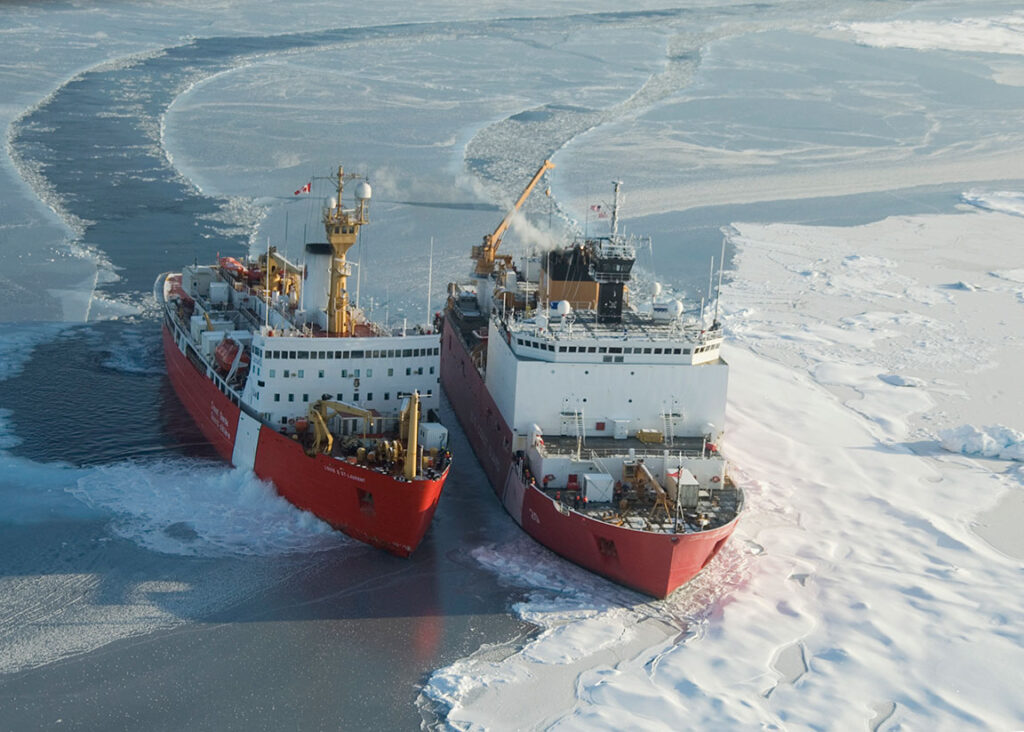The Canadian Coast Guard icebreaker Louis S. St-Laurent maneuvers into position to moor up with the U.S. Coast Guard Cutter Healy during a cooperative science mission to the Arctic Ocean in 2008. U.S. COAST GUARD
THE WATCH STAFF
Canada, Finland and the United States announced a partnership dubbed the Icebreaker Collaboration Effort (ICE Pact) to produce much-needed icebreakers for use in rapidly melting Arctic waters. The July 2024 pact was revealed during the NATO summit in Washington, D.C., and was framed as a way to boost shipbuilding capacity in each country. The agreement is also widely seen as a counter to the People’s Republic of China (PRC) and Russia, whose icebreaker fleets and production capabilities have drawn attention in the West.
By the end of 2024, the three nations will enter a formal understanding on how to best proceed with icebreaker production, according to a joint statement. Bollinger Shipyards in Louisiana will be the building site of future U.S. icebreakers, stated a news release from the White House. “Under this trilateral arrangement, Canadian, Finnish, and American capacity and know-how for building polar icebreakers will help deliver a fleet of new polar icebreakers for ourselves, our allies, and other partners,” the statement read.
The U.S. Coast Guard currently has three icebreakers and several more under order. The ICE Pact will aid allied, democratic nations in improving their shipbuilding capacity while countering PRC and Russian moves in the Arctic, National Security Advisor Jake Sullivan told reporters on the sidelines of the NATO Summit in Washington, D.C, according to Defense One, a military affairs website.
Climate change, which is rapidly opening new shipping and transit routes in the Arctic, is accelerating the importance of these vessels, Sullivan said. “There are authoritarian nations that are making offerings of icebreakers to the world and want to corner the icebreaker market. We’re determined to have democracies be in the lead in producing icebreakers and capabilities,” he said.
Sullivan said the White House hopes the new pact can be a model for future collaboration in shipbuilding between allies and partners, similar to the submarine-building AUKUS agreement of Australia, the United Kingdom and the United States, Defense One reported.
“If we can make this work — and I believe we can make it work — then it becomes a model for other forms of shipbuilding as we go forward, other types of capabilities that we can partner with democracies on. And it becomes a new model for how the United States can both rebuild its own shipbuilding industry and also ensure that we have the industrial base, as the West, to be able to produce the necessary types of every kind of ship,” he said, according to Defense One.
Sullivan’s comments were echoed by a joint statement from the three nations’ leaders. “This partnership will strengthen the shipbuilding industries in each nation with the goal of creating good-paying jobs in shipyards, marine equipment manufacturers, and many other related services across all three countries. In the Arctic, new, faster shipping lanes hold the potential to create new economic opportunities and drive down shipping costs. And in the Antarctic, our partnership can also foster increased scientific research and international collaboration,” the statement read.
But, like AUKUS, the ICE Pact transcends icebreakers, serving as a model for future collaboration and interoperability between allies. “This partnership is about more than the collective production of polar icebreakers and capabilities, including Arctic and polar-capable ships. It is about providing the capability for like-minded nations to uphold international rules, norms, and standards to sustain peace and stability in the Arctic and Antarctic regions for generations to come,” the joint statement read.

